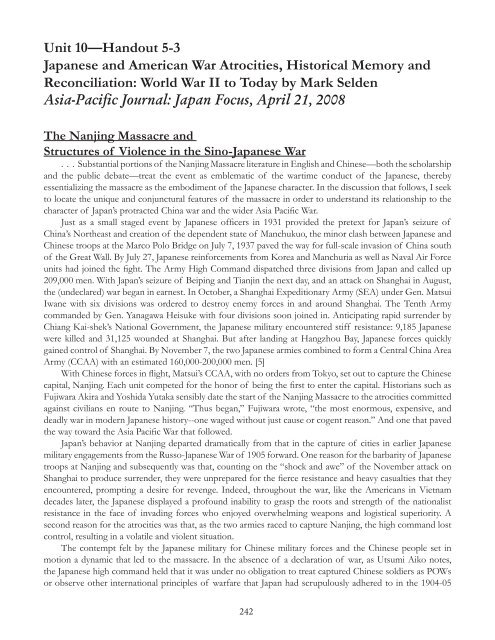Download - Canada ALPHA
Download - Canada ALPHA
Download - Canada ALPHA
You also want an ePaper? Increase the reach of your titles
YUMPU automatically turns print PDFs into web optimized ePapers that Google loves.
Unit 10—Handout 5-3<br />
Japanese and American War Atrocities, Historical Memory and<br />
Reconciliation: World War II to Today by Mark Selden<br />
Asia-Pacific Journal: Japan Focus, April 21, 2008<br />
The Nanjing Massacre and<br />
Structures of Violence in the Sino-Japanese War<br />
. . . Substantial portions of the Nanjing Massacre literature in English and Chinese—both the scholarship<br />
and the public debate—treat the event as emblematic of the wartime conduct of the Japanese, thereby<br />
essentializing the massacre as the embodiment of the Japanese character. In the discussion that follows, I seek<br />
to locate the unique and conjunctural features of the massacre in order to understand its relationship to the<br />
character of Japan’s protracted China war and the wider Asia Pacifi c War.<br />
Just as a small staged event by Japanese offi cers in 1931 provided the pretext for Japan’s seizure of<br />
China’s Northeast and creation of the dependent state of Manchukuo, the minor clash between Japanese and<br />
Chinese troops at the Marco Polo Bridge on July 7, 1937 paved the way for full-scale invasion of China south<br />
of the Great Wall. By July 27, Japanese reinforcements from Korea and Manchuria as well as Naval Air Force<br />
units had joined the fi ght. The Army High Command dispatched three divisions from Japan and called up<br />
209,000 men. With Japan’s seizure of Beiping and Tianjin the next day, and an attack on Shanghai in August,<br />
the (undeclared) war began in earnest. In October, a Shanghai Expeditionary Army (SEA) under Gen. Matsui<br />
Iwane with six divisions was ordered to destroy enemy forces in and around Shanghai. The Tenth Army<br />
commanded by Gen. Yanagawa Heisuke with four divisions soon joined in. Anticipating rapid surrender by<br />
Chiang Kai-shek’s National Government, the Japanese military encountered stiff resistance: 9,185 Japanese<br />
were killed and 31,125 wounded at Shanghai. But after landing at Hangzhou Bay, Japanese forces quickly<br />
gained control of Shanghai. By November 7, the two Japanese armies combined to form a Central China Area<br />
Army (CCAA) with an estimated 160,000-200,000 men. [5]<br />
With Chinese forces in fl ight, Matsui’s CCAA, with no orders from Tokyo, set out to capture the Chinese<br />
capital, Nanjing. Each unit competed for the honor of being the fi rst to enter the capital. Historians such as<br />
Fujiwara Akira and Yoshida Yutaka sensibly date the start of the Nanjing Massacre to the atrocities committed<br />
against civilians en route to Nanjing. “Thus began,” Fujiwara wrote, “the most enormous, expensive, and<br />
deadly war in modern Japanese history--one waged without just cause or cogent reason.” And one that paved<br />
the way toward the Asia Pacifi c War that followed.<br />
Japan’s behavior at Nanjing departed dramatically from that in the capture of cities in earlier Japanese<br />
military engagements from the Russo-Japanese War of 1905 forward. One reason for the barbarity of Japanese<br />
troops at Nanjing and subsequently was that, counting on the “shock and awe” of the November attack on<br />
Shanghai to produce surrender, they were unprepared for the fi erce resistance and heavy casualties that they<br />
encountered, prompting a desire for revenge. Indeed, throughout the war, like the Americans in Vietnam<br />
decades later, the Japanese displayed a profound inability to grasp the roots and strength of the nationalist<br />
resistance in the face of invading forces who enjoyed overwhelming weapons and logistical superiority. A<br />
second reason for the atrocities was that, as the two armies raced to capture Nanjing, the high command lost<br />
control, resulting in a volatile and violent situation.<br />
The contempt felt by the Japanese military for Chinese military forces and the Chinese people set in<br />
motion a dynamic that led to the massacre. In the absence of a declaration of war, as Utsumi Aiko notes,<br />
the Japanese high command held that it was under no obligation to treat captured Chinese soldiers as POWs<br />
or observe other international principles of warfare that Japan had scrupulously adhered to in the 1904-05<br />
242


